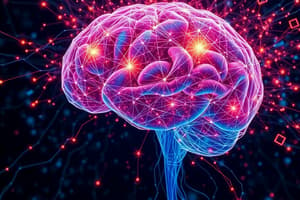Podcast
Questions and Answers
What initiates the opening of voltage-gated Ca2+ channels in the axon terminal?
What initiates the opening of voltage-gated Ca2+ channels in the axon terminal?
- The arrival of an action potential (correct)
- A decrease in membrane potential
- The binding of neurotransmitters
- Calcium ion levels in the synaptic cleft
What process is triggered by the entry of Ca2+ into the axon terminal?
What process is triggered by the entry of Ca2+ into the axon terminal?
- Reuptake of neurotransmitters
- Exocytosis of synaptic vesicles (correct)
- Inhibition of action potentials
- Opening of sodium channels
Which role does the synaptic cleft play during neurotransmitter release?
Which role does the synaptic cleft play during neurotransmitter release?
- It facilitates the binding of neurotransmitters to receptors (correct)
- It generates action potentials
- It produces new synaptic vesicles
- It stores calcium ions
What happens to the neurotransmitter molecules after exocytosis?
What happens to the neurotransmitter molecules after exocytosis?
Which best describes the role of calcium ions during neurotransmitter release?
Which best describes the role of calcium ions during neurotransmitter release?
Which mechanism terminates the action potential along an axon?
Which mechanism terminates the action potential along an axon?
How does depolarization affect the postsynaptic cell?
How does depolarization affect the postsynaptic cell?
What role does the docking protein play in synaptic transmission?
What role does the docking protein play in synaptic transmission?
What initiates the release of neurotransmitters from synaptic vesicles?
What initiates the release of neurotransmitters from synaptic vesicles?
Which of the following steps occurs first during synaptic transmission?
Which of the following steps occurs first during synaptic transmission?
What is the primary function of neurotransmitters at a chemical synapse?
What is the primary function of neurotransmitters at a chemical synapse?
What happens after neurotransmitters bind to receptors on the postsynaptic cell?
What happens after neurotransmitters bind to receptors on the postsynaptic cell?
Which event occurs first during the transmission at a chemical synapse?
Which event occurs first during the transmission at a chemical synapse?
Which event directly follows calcium influx in the presynaptic terminal?
Which event directly follows calcium influx in the presynaptic terminal?
What is the role of the synaptic cleft in neurotransmission?
What is the role of the synaptic cleft in neurotransmission?
What role do docking proteins play in synaptic transmission?
What role do docking proteins play in synaptic transmission?
How does an action potential lead to neurotransmitter release?
How does an action potential lead to neurotransmitter release?
What type of synapse uses neurotransmitters to communicate between neurons?
What type of synapse uses neurotransmitters to communicate between neurons?
What is the primary cause of the depolarization of the axon terminal during an action potential?
What is the primary cause of the depolarization of the axon terminal during an action potential?
Which statement best describes the synaptic cleft?
Which statement best describes the synaptic cleft?
What happens when calcium ions enter the presynaptic neuron?
What happens when calcium ions enter the presynaptic neuron?
How does the entry of calcium ions (Ca2+) affect synaptic transmission?
How does the entry of calcium ions (Ca2+) affect synaptic transmission?
What type of electrical signal typically leads to the release of neurotransmitters at a synapse?
What type of electrical signal typically leads to the release of neurotransmitters at a synapse?
What is the effect of an excitatory neurotransmitter on a postsynaptic neuron?
What is the effect of an excitatory neurotransmitter on a postsynaptic neuron?
Flashcards
Synaptic vesicle
Synaptic vesicle
A small sac that stores neurotransmitters.
Neurotransmitter
Neurotransmitter
Chemical messenger between neurons.
Action potential
Action potential
Electrical signal that travels down a neuron.
Synaptic cleft
Synaptic cleft
Signup and view all the flashcards
Voltage-gated Calcium channels
Voltage-gated Calcium channels
Signup and view all the flashcards
Exocytosis
Exocytosis
Signup and view all the flashcards
Postsynaptic cell
Postsynaptic cell
Signup and view all the flashcards
Receptor
Receptor
Signup and view all the flashcards
What triggers exocytosis?
What triggers exocytosis?
Signup and view all the flashcards
How does an action potential cause neurotransmitter release?
How does an action potential cause neurotransmitter release?
Signup and view all the flashcards
Synaptic vesicle docking
Synaptic vesicle docking
Signup and view all the flashcards
What is the role of calcium channels?
What is the role of calcium channels?
Signup and view all the flashcards
What is the synaptic cleft?
What is the synaptic cleft?
Signup and view all the flashcards
What is the function of docking proteins?
What is the function of docking proteins?
Signup and view all the flashcards
How does the axon terminal depolarize?
How does the axon terminal depolarize?
Signup and view all the flashcards
Why is calcium important for neurotransmitter release?
Why is calcium important for neurotransmitter release?
Signup and view all the flashcards
What happens when an action potential reaches the axon terminal?
What happens when an action potential reaches the axon terminal?
Signup and view all the flashcards
What is the role of synaptic vesicles?
What is the role of synaptic vesicles?
Signup and view all the flashcards
How do neurotransmitters reach the postsynaptic neuron?
How do neurotransmitters reach the postsynaptic neuron?
Signup and view all the flashcards
What happens to neurotransmitters in the synaptic cleft?
What happens to neurotransmitters in the synaptic cleft?
Signup and view all the flashcards
What happens to neurotransmitters after binding?
What happens to neurotransmitters after binding?
Signup and view all the flashcards
What are the two main types of synapses?
What are the two main types of synapses?
Signup and view all the flashcards
What is a post-synaptic potential?
What is a post-synaptic potential?
Signup and view all the flashcards
What are the two types of post-synaptic potentials?
What are the two types of post-synaptic potentials?
Signup and view all the flashcards
Study Notes
Lecture 4: Integration of Signals
- This lecture covers the integration of signals in the nervous system
- Chemical synapses are points of interaction in the nervous system, transmitting electrical signals between cells
- Chemical synapses use neurotransmitters (NTs) released from presynaptic neurons to bind to receptors on postsynaptic neurons
- Two types of synapses exist
- Presynaptic neurons send signals toward a synapse
- Postsynaptic neurons transmit signals away from a synapse
- The nervous system uses summation of graded potentials to trigger action potentials
- Types of summation are temporal and spatial
- Temporal summation is when a presynaptic neuron fires repeatedly at high rates
- Spatial summation is when multiple presynaptic neurons fire at the same time, creating a larger change in membrane potential
- Graded potentials can be excitatory or inhibitory, affecting the likelihood of reaching threshold for an action potential at the axon hillock
- Spinal reflexes are simple behaviors produced by the central nervous system pathways entirely in the spinal cord
- A reflex arc involves five components: receptor, sensory neuron, integration center, motor neuron, and effector
- Examples given for a reflex action are the patellar tendon reflex (also known as the knee-jerk reflex)
- Extension is the straightening of a joint, while flexion is bending the joint
- Homeostasis is the maintenance of a relatively constant internal environment in the body
- Homeostasis is a dynamic process involving mechanisms to regulate body temperature, volume, and composition
- Negative feedback is a common control system in the body, responding to deviations from set points by initiating changes in the opposite direction
- Excitatory postsynaptic potentials (EPSPs) increase the likelihood of an action potential
- Inhibitory postsynaptic potentials (IPSPs) decrease the likelihood of an action potential
- Homeostatic control reflex systems maintain body temperature when there are changes in room temperature
Types of neurons
- Three types of neurons are present in the nervous system
- Sensory neurons carry signals from sensory receptors to the central nervous system
- Motor neurons carry signals to effector cells to determine an appropriate effector response
- Interneurons play a role integrating information within the central nervous system and connecting to motor neurons. They process signals such as emotions, learning, and memory
Neuronal circuits
- Divergence
- Information from a single neuron to multiple neurons. A mechanism for spreading signals to multiple neurons in the CNS
- Convergence
- Several neurons synapse with a single postsynaptic neuron. A mechanism for providing input to a single neuron from multiple sources
Chemical Messengers
- Neurotransmitters bind to receptors on postsynaptic neurons to trigger a response.
- Autocrine substances affect the same cell that makes them
- Paracrine substances affect cells near the source
- Hormones travel through the blood to distant target cells in the body
Termination of neurotransmitter Effects
- Neurotransmitters are removed from the synaptic cleft
- Enzymes inactivate neurotransmitters
- Neurotransmitters are reabsorbed into presynaptic terminals or transported into glial cells
Basic Concepts in Biomedical Sciences I
- Chapter 2, Homeostasis, pages 8-13 are suggested reading for further study
Studying That Suits You
Use AI to generate personalized quizzes and flashcards to suit your learning preferences.





